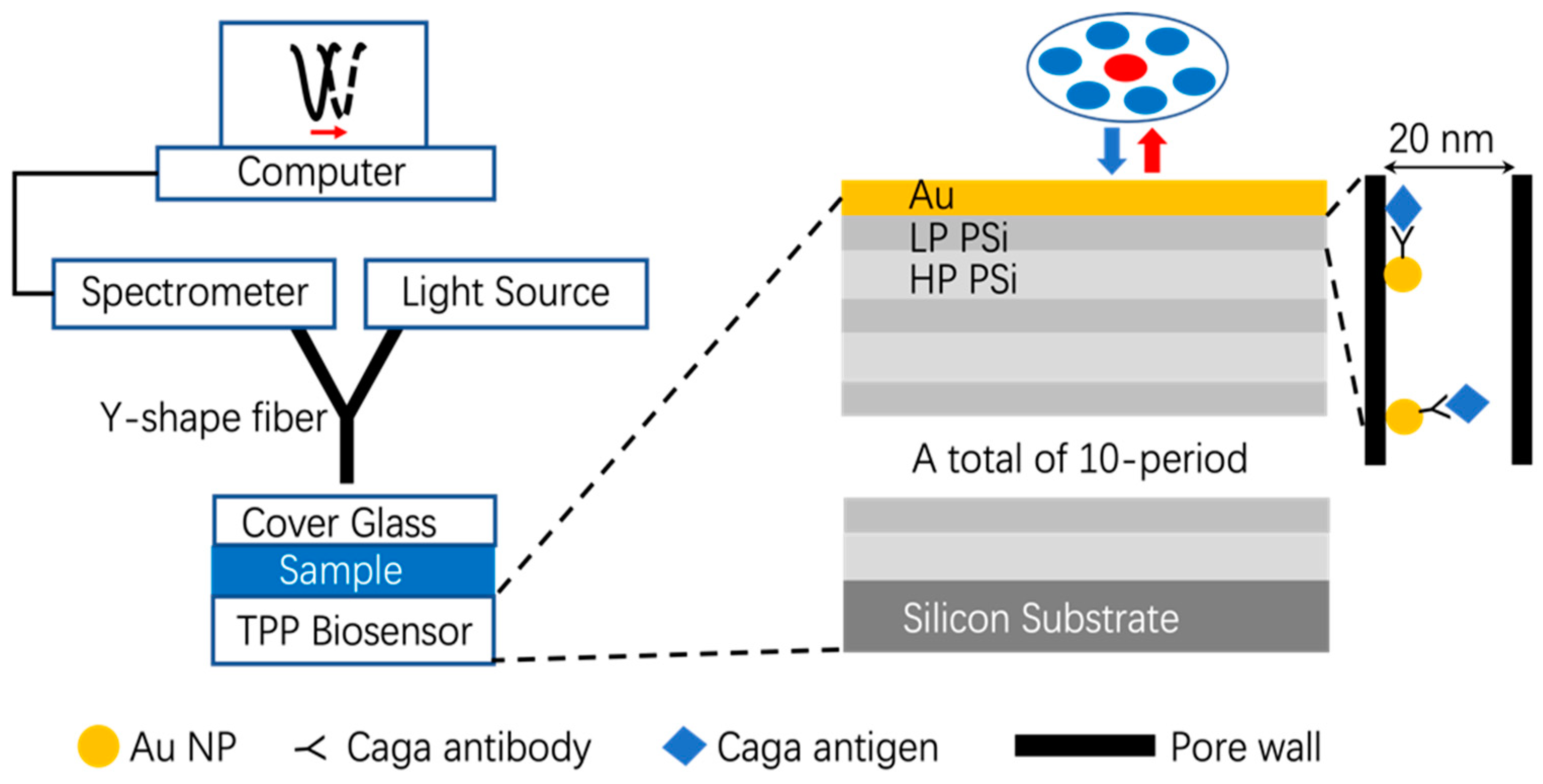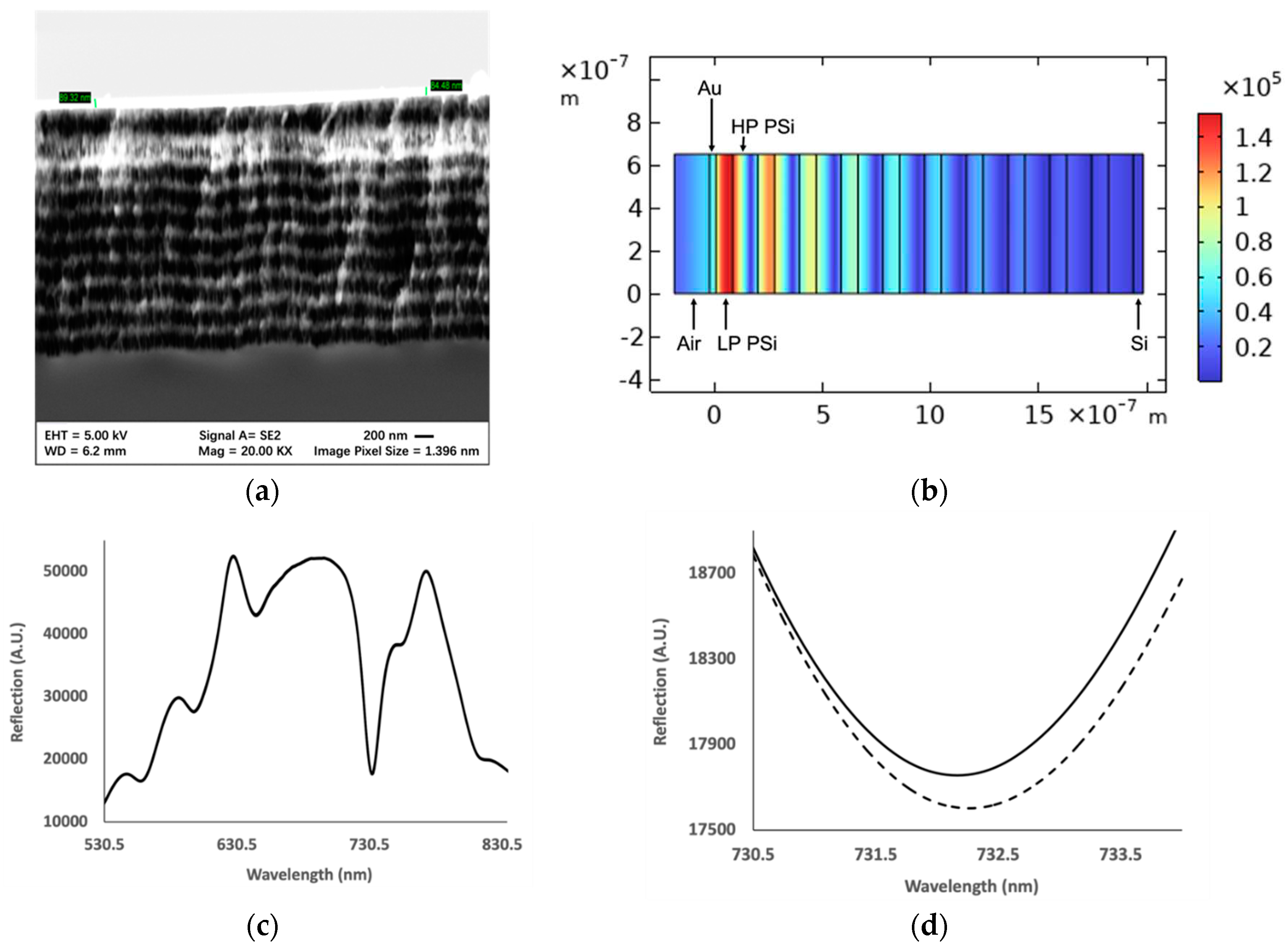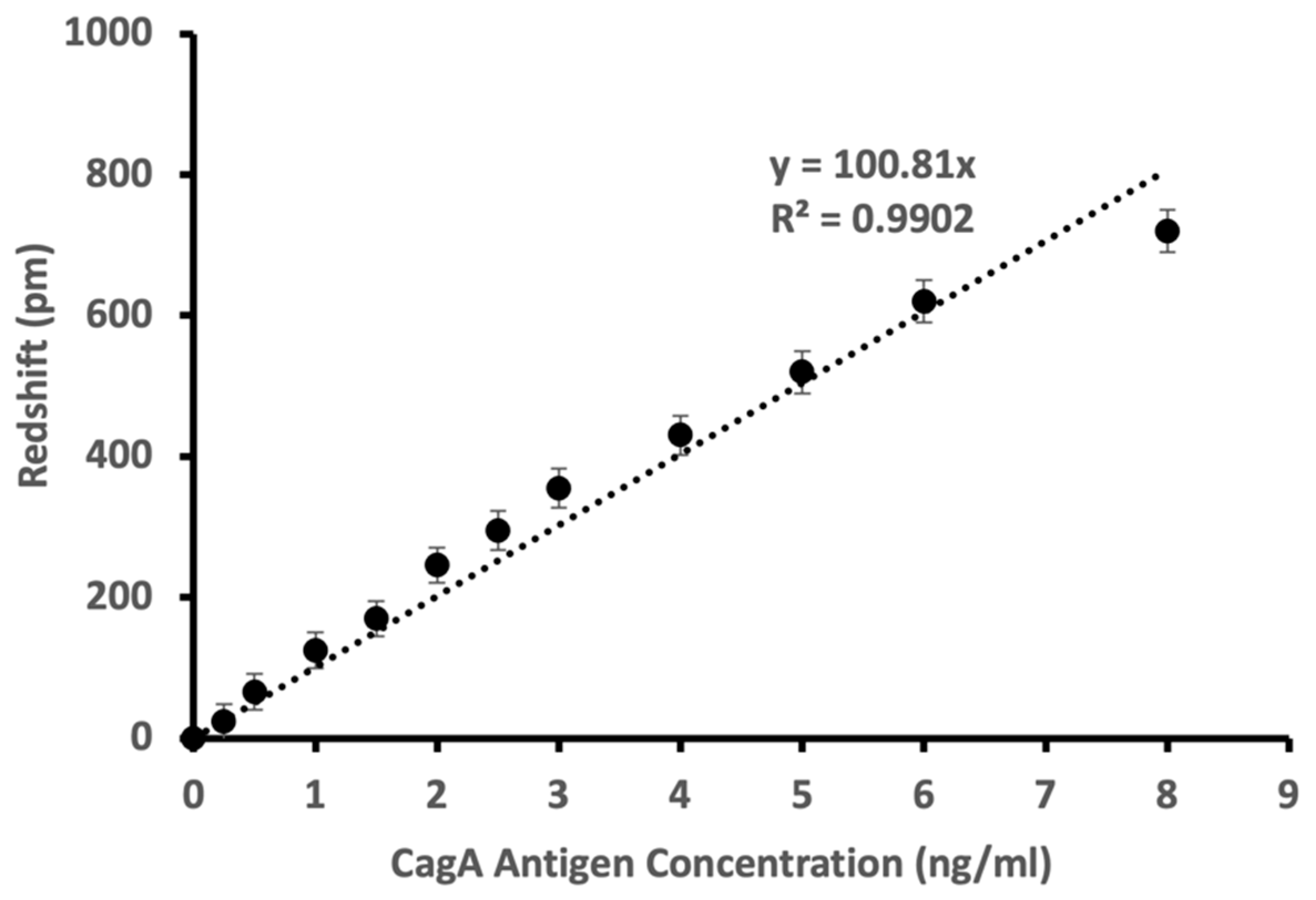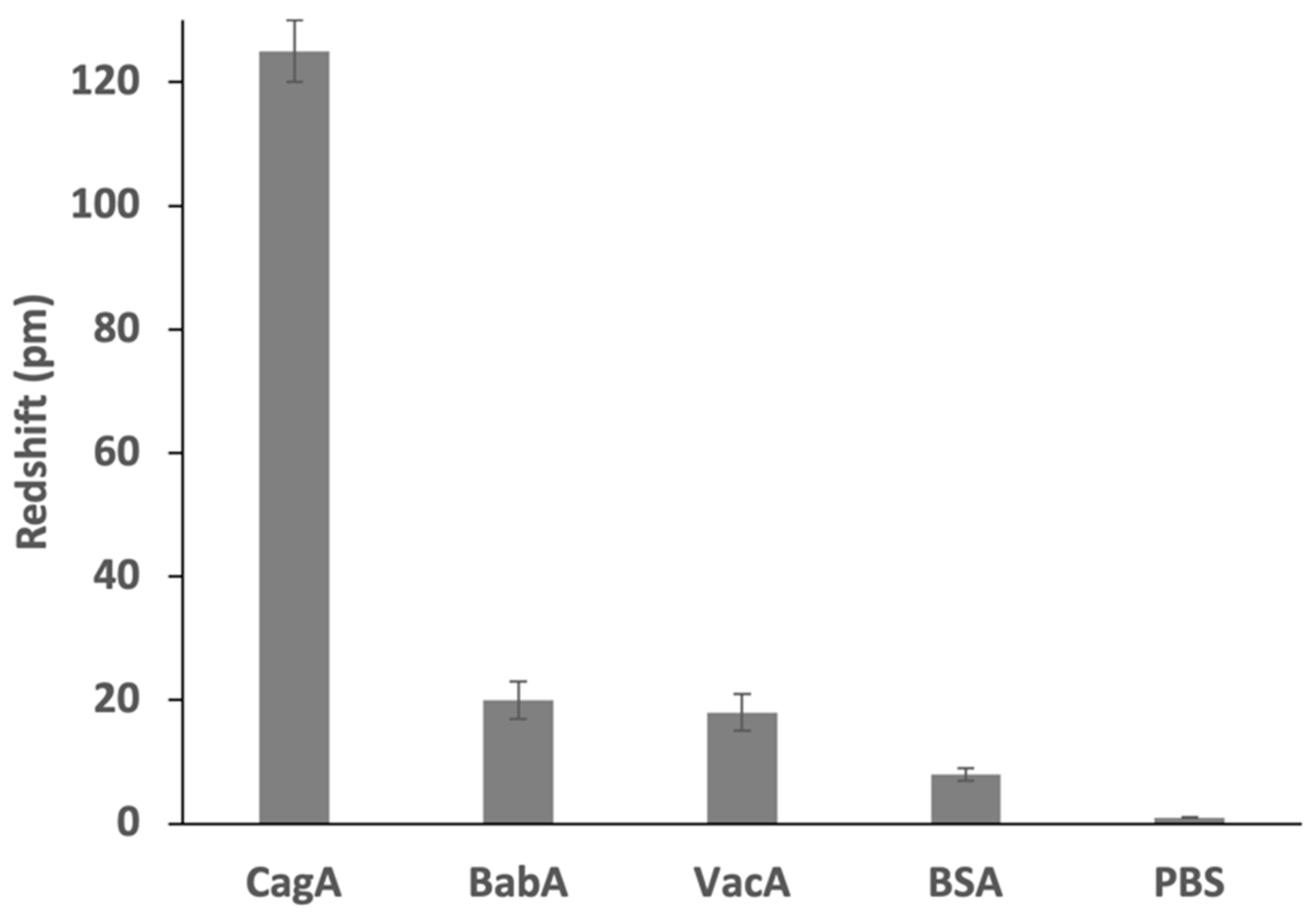Submitted:
30 January 2024
Posted:
31 January 2024
You are already at the latest version
Abstract
Keywords:
Introduction
Materials and Methods
Results and Discussion
Conclusion
Author Contributions
Funding
Institutional Review Board Statement
Informed Consent Statement
Data Availability Statement
Conflicts of Interest
References
- Leja, M., A. Axon, and H. Brenner, Epidemiology of Helicobacter pylori infection. Helicobacter, 2016. 21: p. 3-7. [CrossRef]
- de Brito, B.B., et al., Pathogenesis and clinical management of Helicobacter pylori gastric infection. World Journal of Gastroenterology, 2019. 25(37): p. 5578-5589. [CrossRef]
- Sun, Q.F., et al., Helicobacter pylori infection: a dynamic process from diagnosis to treatment. Frontiers in Cellular and Infection Microbiology, 2023. 13. [CrossRef]
- Malfertheiner, P., et al., Management of infection: the Maastricht VI/Florence consensus report. Gut, 2022. 71(9): p. 1724-1762. [CrossRef]
- Llorca, L., et al., Comparative, Prospective, Study Comparing the Accuracy of Two Different Stool Antigen Tests (Premier Platinum Hpsa and Novel Immunocard Stat! Rapid Test) for the Diagnosis of Infection: Preliminary Results. Helicobacter, 2015. 20: p. 88-88. [CrossRef]
- Su, X.D. and S.F.Y. Li, Serological determination of infection using sandwiched and enzymatically amplified piezoelectric biosensor. Analytica Chimica Acta, 2001. 429(1): p. 27-36. [CrossRef]
- Ly, S.Y., H.S. Yoo, and S.H. Choa, Diagnosis of bacterial infections using a voltammetric biosensor. Journal of Microbiological Methods, 2011. 87(1): p. 44-48. [CrossRef]
- Shahrashoob, M., et al., Detection of Genome with an Optical Biosensor Based on Hybridization of Urease Gene with a Gold Nanoparticles-Labeled Probe. Journal of Applied Spectroscopy, 2016. 83(2): p. 322-329. [CrossRef]
- Sezgin, G.C. and I. Ocsoy, Anthocyanin-rich black carrot (ssp. sativus var. atrorubens Alef.) and red cabbage () extracts incorporated biosensor for colorimetric detection of with color image processing. Brazilian Journal of Microbiology, 2023. 54(2): p. 897-905. [CrossRef]
- Ono, S., et al., Accuracies of Endoscopic Diagnosis of Gastritis: Multicenter Prospective Study Using White Light Imaging and Linked Color Imaging. Digestion, 2020. 101(5): p. 624-630. [CrossRef]
- Akeel, M., et al., Efficacy of immunohistochemical staining in detecting in Saudi patients with minimal and atypical infection. European Journal of Histochemistry, 2021. 65(3). [CrossRef]
- Malfertheiner, P., et al., Management of infection-the Maastricht IV/ Florence Consensus Report. Gut, 2012. 61(5): p. 646-664. [CrossRef]
- Wong, A., S.S. Ching, and A.S. Long, The use of a second biopsy from the gastric body for the detection of using rapid urease test. Singapore Medical Journal, 2014. 55(12): p. 644-647. [CrossRef]
- Bénéjat, L., et al., Real-time PCR for diagnosis. The best tools available. Helicobacter, 2018. 23(5). [CrossRef]
- Rong, G., et al., Nanoscale porous silicon waveguide for label-free DNA sensing. Biosensors & Bioelectronics, 2008. 23(10): p. 1572-1576. [CrossRef]
- Verma, Y.K., S. Kumari, and S.M. Tripathi, Grating assisted temperature insensitive micro-ring resonator biosensor. Journal of Optics, 2023. 25(12). [CrossRef]
- Wu, B., et al., A Nanoscale Porous Silicon Microcavity Biosensor for Novel Label-Free Tuberculosis Antigen-Antibody Detection. Nano, 2012. 7(6). [CrossRef]
- Nagarathnegowda, M., et al., A Gallium arsenide composite semi-conductive material-based 2D photonic crystal biosensor for cancer cell detection. Optical and Quantum Electronics, 2023. 55(12). [CrossRef]
- Esmailidastjerdipour, P. and F. Shahshahani, Numerical Simulation of Fiber Optic Biosensor Consisting of Metal/ScO Enhancing by Using Aluminum Alloy for Hydrotherapy Applications. Plasmonics, 2023. [CrossRef]
- Das, C.M., et al., Computational Modeling for Intelligent Surface Plasmon Resonance Sensor Design and Experimental Schemes for Real-Time Plasmonic Biosensing: A Review. Advanced Theory and Simulations, 2023. 6(9). [CrossRef]
- Semwal, V., et al., Investigation of Performance Parameters of Spherical Gold Nanoparticles in Localized Surface Plasmon Resonance Biosensing. Micromachines, 2023. 14(9). [CrossRef]
- Tripathi, M.N., et al., A novel approach for rapid and sensitive detection of Zika virus utilizing silver nanoislands as SERS platform. Spectrochimica Acta Part a-Molecular and Biomolecular Spectroscopy, 2023. 302. [CrossRef]
- Wan, Y.H., et al., Resonant Mode Engineering of Photonic Crystal Sensors Clad with Ultralow Refractive Index Porous Silicon Dioxide. Advanced Optical Materials, 2017. 5(21). [CrossRef]
- Rong, G.G., et al., A high-throughput fully automatic biosensing platform for efficient COVID-19 detection. Biosensors & Bioelectronics, 2023. 220. [CrossRef]
- Rong, G.G., et al., A Closed-Loop Approach to Fight Coronavirus: Early Detection and Subsequent Treatment. Biosensors-Basel, 2022. 12(10). [CrossRef]
- Rong, G.G. and M. Sawan, Tamm Plasmon Polariton Biosensors Based on Porous Silicon: Design, Validation and Analysis. Biosensors-Basel, 2023. 13(12). [CrossRef]
- Kaliteevski, M., et al., Tamm plasmon-polaritons: Possible electromagnetic states at the interface of a metal and a dielectric Bragg mirror. Physical Review B, 2007. 76(16). [CrossRef]
- Vyunishev, A.M., et al., Broadband Tamm plasmon polariton. Journal of the Optical Society of America B-Optical Physics, 2019. 36(8): p. 2299-2305. [CrossRef]
- Rong, G.G., Y.K. Xu, and M. Sawan, Machine Learning Techniques for Effective Pathogen Detection Based on Resonant Biosensors. Biosensors-Basel, 2023. 13(9). [CrossRef]
- Umit, H., et al., The Relationship Between Virulence Factors of Helicobacter pylori and Severity of Gastritis in Infected Patients. Digestive Diseases and Sciences, 2009. 54(1): p. 103-110. [CrossRef]
- Ni, H.K., et al., The relationship between gastric cancer and Helicobacter pylori cytotoxin-related gene A genotypes. Cellular and Molecular Biology, 2020. 66(7): p. 1-4. [CrossRef]
- Jain, U., et al., Triple-nanostructuring-based noninvasive electro-immune sensing of CagA toxin for detection. Helicobacter, 2020. 25(4). [CrossRef]
- Saxena, K., et al., Fabrication of a Molecularly Imprinted Nano-Interface-Based Electrochemical Biosensor for the Detection of CagA Virulence Factors of. Biosensors-Basel, 2022. 12(12). [CrossRef]
- Chauhan, N., et al., Zinc Oxide Tetrapods Based Biohybrid Interface for Voltammetric Sensing of. Acs Applied Materials & Interfaces, 2018. 10(36): p. 30631-30639. [CrossRef]
- Kumar, M. and S. Prasad, High-Resolution Temperature Sensor Based on Resonance Excitation of Tamm Plasmon Polaritons: Graphene Plasmon Polariton Hybrid Mode. Journal of Electronic Materials, 2023. 52(8): p. 5337-5344. [CrossRef]
- Wu, F., et al., Broadband wide-angle multilayer absorber based on a broadband omnidirectional optical Tamm state. Optics Express, 2021. 29(15): p. 23976-23987. [CrossRef]
- Wang, Z.Y., et al., High and Tailorable Fano Resonances in a One-Dimensional Metal-Optical Tamm State Structure: From a Narrowband Perfect Absorber to a Narrowband Perfect Reflector. Advanced Functional Materials, 2021. 31(26). [CrossRef]
- He, M.Z., et al., Deterministic inverse design of Tamm plasmon thermal emitters with multi-resonant control. Nature Materials, 2021. 20(12): p. 1663-+. [CrossRef]




| Detection Techniques | Pros | Cons | |
|---|---|---|---|
| Non-invasive test methods (Endoscopy not required) |
Serological test [6] | No side effects on patients | Positive results may not mean persistent infection |
| Stool antigen test [5] | Easy operation | Fecal sample handling may affect results | |
| Urea breath test [4] | Easy operation | Drugs taken by patients may impact accuracy | |
| Biosensors [7,8,9] | Easy operation, high sensitivity | Specificity may be affected by interferents in samples | |
| Invasive test methods (Endoscopy required) | Endoscopy [10] | Gastric pathology observation available | Accuracy may vary drastically depending on operator experiences |
| Culturing [12] | Highly specific due to controlled culturing conditions | Long turnaround time and vulnerability of results to culturing conditions | |
| Histological test [11] | High sensitivity and specificity | Accuracy may vary drastically depending on operator experiences | |
| Rapid urease test [13] | Rapid and easy to operate | Bacterium may not be present in biopsy | |
| Polymerase chain reaction (PCR) [14] |
Accurate and high throughput capability | Need clean environment, samples may contain PCR blockers | |
| Porous Silicon Layer | Current Density | Anodization Time | Porosity of Layer | Optical Refractive Index | Thickness of Layer |
|---|---|---|---|---|---|
| Low Porosity (LP PSi) | 5 mA/cm2 | 20 seconds | 52% | 2.08 | 100 nm |
| High Porosity (HP PSi) | 48 mA/cm2 | 6 seconds | 76% | 1.46 | 150 nm |
| No | Step Name | Step Operation |
|---|---|---|
| 1 | Chip cleaning | Clean the surface of the chip separately with anhydrous ethanol and ultrapure water, blow dry the water, and set aside. |
| 2 | Carboxyla-tion modification | Dilute the polycarboxylation reagent (Xlement Cat. No. G40005) to 100µM working concentration with ultrapure water, take an appropriate amount of carboxylation reagent and add it to the surface of the chip. Leave it at 4°C overnight or 37°C for 4 hours. |
| 3 | Activation of functional groups on surface of biosensors |
Wash the carboxylated modified chip three times with ultrapure water and blow dry the moisture. Prepare the experimental chip card following standard operating procedures and connect it to the corresponding flow interface in sequence. Prepare an activation reagent solution with a final concentration of 10 mM using 100 mM activation buffer solution (Xlement Cat. No. S20028), and inject 100 µl activation reagent (prepare when need to use) into the chip with a flow rate of 10 μl/min, Running buffer is the activation buffer. |
| 4 | Preparation of immobiliza- tion antibody solution |
Prepare solution of capture antibodies against CagA antigen of Helicobacter Pylori and dilute with a coupling buffer solution (Xlement Cat. No. S20029) to 15μg/ml concentration for later use. |
| 5 | Chip conjugation with antibody | Take an appropriate amount of capture antibody (CagA antibody) solution and add it to the surface of the chip. Inject 100 μl the capture antibody solution into the chip at a flow rate of 10 μl/min. Running buffer is the conjugation buffer. |
| 6 | Sealing | Take an appropriate amount of sealing buffer solution (Xlement Cat. No. G30004) and add it to the surface of the chip. Inject 100 μl sealing buffer solution into the chip with a flow rate of 10 μ l/min, the Running buffer is the sealing buffer. |
| 7 | Storage | The biosensors can be stored for 3-5 days under 37°C, two months under 25°C, and 6 months under 2-8°C. |
| 8 | Biosensing | Restore the biosensors to room temperature of 25-27°C. Drop 20 µl of CagA antigen solution in varying concentrations in PBS buffer on biosensor surface. Put on cover glass and take spectral measurement with fiber spectrometer. |
| Biosensor Technique | Sensitivity | LOD (ng/ml) |
Linear Range (ng/ml) |
Positive-to -Negative Ratio |
|---|---|---|---|---|
| Amperometric [32] | 656.0 µA/(ng/ml) |
0.10 | 0.1-8 | >5 |
| Electrochemical [33] | 0.275 µA/(ng/ml) |
0.05 | 0.05-50 | ~4 |
| Voltametric [34] | 1.0 µA/(ng/ml) | 0.20 | 0.2-50 | >5 |
| TPP (This work) | 100 pm/(ng/ml) | 0.01 | 0.25-8 | >6 |
Disclaimer/Publisher’s Note: The statements, opinions and data contained in all publications are solely those of the individual author(s) and contributor(s) and not of MDPI and/or the editor(s). MDPI and/or the editor(s) disclaim responsibility for any injury to people or property resulting from any ideas, methods, instructions or products referred to in the content. |
© 2024 by the authors. Licensee MDPI, Basel, Switzerland. This article is an open access article distributed under the terms and conditions of the Creative Commons Attribution (CC BY) license (http://creativecommons.org/licenses/by/4.0/).





